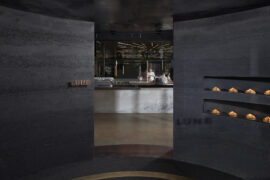How does design impact all elements of our communal and individual living conditions? Here we ask Gaggenau about the secret to innovating!

The Vario 400 Series: Gaggenau
How design holds the power to impact every element of our personal lives today is a question that the INDE Living Space Award for 2017 seeks to uncover. However, thanks to the Living Space Official Partner – German brand Gaggenau – one answer to this question becomes immediately evident. And to the pleasure of everyone at Indesign Media Asia Pacific, it involves food!
As globalisation opens up previously closed markets and exposes local cuisine to international influence, exposure to an enormous array of new ingredients, cooking methods, technologies, and traditions inherent in our daily lives have often undergone change. As a mainstay to social and cultural identity, one cannot underestimate the importance of food and the delicate position it maintains in our daily lives: always adapting to new forces, constantly responding to a world of inspirations and serving as the stimuli for many aspects by which we commune. Of course, design has a large say in how we approach such a personal aspect of our lives. From the discovery of fire to the first simple ovens used to make bread and other baked goods, the design of cooking technologies has always had a direct impact on the food that we produce and the day-to-day traditions we partake, as a result.
It all started in 1683, in a small village at the foot of the Black Forest, when Margrave Ludwig Wilhelm von Baden set up an ironworks. By using iron ore deposits in the valley, he was able to generate new sources of income for the impoverished farmers and lay the foundations for the future success of Gaggenau. In 1873 the company’s core products were agricultural machinery, metalware and tools but by 1880, its robust oven enamel saw coal and gas-fired stoves become its big success story and these continued to be manufactured until well into the 20th century.
However, it was in 1931 that the company truly proved its pioneer status by producing the first electric stoves, making cooking safer and more convenient. It continued to develop these and by 1948, 180 employees were involved in producing the Favorit and Futura electric ovens, which proved hugely popular. Gaggenau also launched innovative ovens that required a lot less coal and gas to run, giving the brand a reputation as the economical choice of the era.
Meanwhile, in 1945 Japan, Shigeji Fujioka was establishing Teppanyaki Misono: the first restaurant to cook food in the now infamous teppanyaki style on an iron griddle. The restaurant proved a turning point for post-war Japanese culture, with the fast, theatrical style of cooking proving popular with Western soldiers stationed in the region, despite not being met with initial enthusiasm from the local population. Teppanyaki has since spread around the world, combining recognisably Japanese ingredients with a brash cooking method unfamiliar to the Japanese at the time.
Both of these historical happenstances speak strongly to the curative and transformative power of design in our personal lives – as individuals and communities – and display a particularly touching degree of what often goes unremarked in A+D creative practice: bravery and compassion.
Now, some 70 odd years later, teppanyaki is still cooked on cast iron, but more and more chefs and kitchens alike are turning to stainless steel for its material advantages. And for the first time, Gaggenau and teppanyaki have come together, with the German brand recently introducing an in-built stainless steel teppanyaki cooktop in the form of their Vario Teppan Yaki 400 series. Having expanded well beyond Germany into 50 countries across the globe, the developments made by the oldest appliances company in the world are no longer restricted to one part of the world, nor are they restricted to innovating for an isolated context.
Your kitchen isn’t restricted to one part of the world, either.
INDESIGN is on instagram
Follow @indesignlive
A searchable and comprehensive guide for specifying leading products and their suppliers
Keep up to date with the latest and greatest from our industry BFF's!

For Aidan Mawhinney, the secret ingredient to Living Edge’s success “comes down to people, product and place.” As the brand celebrates a significant 25-year milestone, it’s that commitment to authentic, sustainable design – and the people behind it all – that continues to anchor its legacy.

Welcomed to the Australian design scene in 2024, Kokuyo is set to redefine collaboration, bringing its unique blend of colour and function to individuals and corporations, designed to be used Any Way!

Recognised as winners at the INDE.Awards 2025, Enter Projects Asia in collaboration with SOM have received The Influencer award. Their work on Terminal 2 Kempegowda International Airport Interiors redefines the aesthetics of airport design through a monumental expression of biophilia, sustainability and craftsmanship.

Recognised as a winner at the INDE.Awards 2025, Barton Taylor has received The Photographer – Residential accolade. His photographic work on Cake House captures the soul of a coastal icon reimagined, blending light, texture and atmosphere into a compelling visual narrative.

Cieran Murphy has been awarded The Photographer – Commercial at the INDE.Awards 2025. His work on Lune Rosebery captures the immersive design and storytelling of the space, highlighting the interplay of form, material and atmosphere in this contemporary culinary destination.

Central Station by Woods Bagot in collaboration with John McAslan + Partners has been named one of two joint winners of The Building category at the INDE.Awards 2025. Recognised alongside BVN’s Sirius Redevelopment, the project redefines Sydney’s historic transport hub through a transformative design that connects heritage with the demands of a modern, growing city.
The internet never sleeps! Here's the stuff you might have missed

Entertaining outdoors is fundamental to Italian culture, and homes, hotels and restaurants embrace patios, terraces and gardens that celebrate scenery, climate and comfort.

The FlexiFlange leak control flange is set to revolutionise the task of installing drainage systems alongside vertical surfaces like walls and floor junctions.

IF Architecture crafts Baker Bleu Cremorne into a refined, sustainable bakery and café where industrial design meets artisanal warmth.

Central Station by Woods Bagot in collaboration with John McAslan + Partners has been named one of two joint winners of The Building category at the INDE.Awards 2025. Recognised alongside BVN’s Sirius Redevelopment, the project redefines Sydney’s historic transport hub through a transformative design that connects heritage with the demands of a modern, growing city.